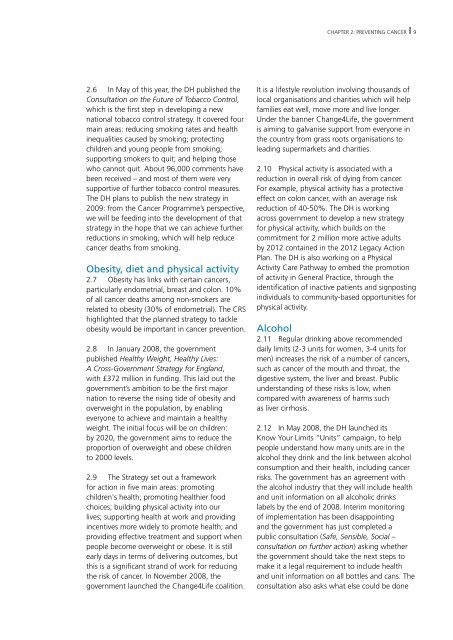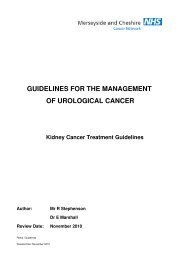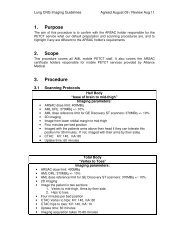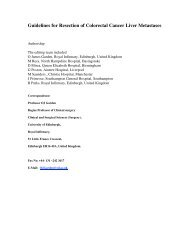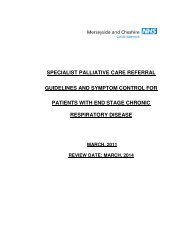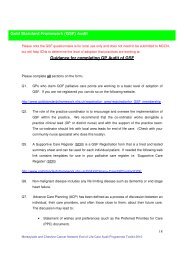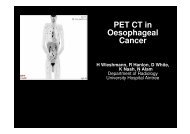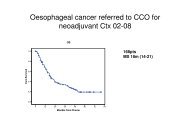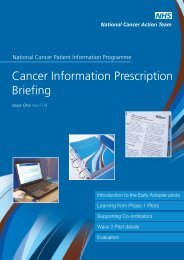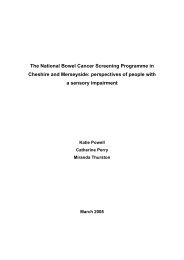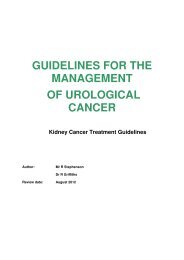Cancer Reform Strategy - First Annual Report - Merseyside ...
Cancer Reform Strategy - First Annual Report - Merseyside ...
Cancer Reform Strategy - First Annual Report - Merseyside ...
Create successful ePaper yourself
Turn your PDF publications into a flip-book with our unique Google optimized e-Paper software.
CHAPTER 2: PREVENTINg CANCER 92.6 In May of this year, the DH published theConsultation on the Future of Tobacco Control,which is the first step in developing a newnational tobacco control strategy. It covered fourmain areas: reducing smoking rates and healthinequalities caused by smoking; protectingchildren and young people from smoking;supporting smokers to quit; and helping thosewho cannot quit. About 96,000 comments havebeen received – and most of them were verysupportive of further tobacco control measures.The DH plans to publish the new strategy in2009: from the <strong>Cancer</strong> Programme’s perspective,we will be feeding into the development of thatstrategy in the hope that we can achieve furtherreductions in smoking, which will help reducecancer deaths from smoking.Obesity, diet and physical activity2.7 obesity has links with certain cancers,particularly endometrial, breast and colon. 10%of all cancer deaths among non-smokers arerelated to obesity (30% of endometrial). The CRShighlighted that the planned strategy to tackleobesity would be important in cancer prevention.2.8 In January 2008, the governmentpublished Healthy Weight, Healthy Lives:A Cross-Government <strong>Strategy</strong> for England,with £372 million in funding. This laid out thegovernment’s ambition to be the first majornation to reverse the rising tide of obesity andoverweight in the population, by enablingeveryone to achieve and maintain a healthyweight. The initial focus will be on children:by 2020, the government aims to reduce theproportion of overweight and obese childrento 2000 levels.2.9 The <strong>Strategy</strong> set out a frameworkfor action in five main areas: promotingchildren's health; promoting healthier foodchoices; building physical activity into ourlives; supporting health at work and providingincentives more widely to promote health; andproviding effective treatment and support whenpeople become overweight or obese. It is stillearly days in terms of delivering outcomes, butthis is a significant strand of work for reducingthe risk of cancer. In November 2008, thegovernment launched the Change4life coalition.It is a lifestyle revolution involving thousands oflocal organisations and charities which will helpfamilies eat well, move more and live longer.Under the banner Change4life, the governmentis aiming to galvanise support from everyone inthe country from grass roots organisations toleading supermarkets and charities.2.10 Physical activity is associated with areduction in overall risk of dying from cancer.For example, physical activity has a protectiveeffect on colon cancer, with an average riskreduction of 40-50%. The DH is workingacross government to develop a new strategyfor physical activity, which builds on thecommitment for 2 million more active adultsby 2012 contained in the 2012 legacy ActionPlan. The DH is also working on a PhysicalActivity Care Pathway to embed the promotionof activity in general Practice, through theidentification of inactive patients and signpostingindividuals to community-based opportunities forphysical activity.Alcohol2.11 Regular drinking above recommendeddaily limits (2-3 units for women, 3-4 units formen) increases the risk of a number of cancers,such as cancer of the mouth and throat, thedigestive system, the liver and breast. Publicunderstanding of these risks is low, whencompared with awareness of harms suchas liver cirrhosis.2.12 In May 2008, the DH launched itsKnow your limits “Units” campaign, to helppeople understand how many units are in thealcohol they drink and the link between alcoholconsumption and their health, including cancerrisks. The government has an agreement withthe alcohol industry that they will include healthand unit information on all alcoholic drinkslabels by the end of 2008. Interim monitoringof implementation has been disappointingand the government has just completed apublic consultation (Safe, Sensible, Social –consultation on further action) asking whetherthe government should take the next steps tomake it a legal requirement to include healthand unit information on all bottles and cans. Theconsultation also asks what else could be done


